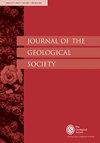Sommerodde(Telychian,志留纪)正碳同位素漂移:为什么它的震级如此多变?
IF 3
3区 地球科学
Q2 GEOSCIENCES, MULTIDISCIPLINARY
引用次数: 0
摘要
在丹麦Bornholm的Sommerodde-1岩心中,首次发现了位于Oktavites spiralis笔石生物带(Telychian,志留纪)内的Sommerodde阳性有机碳同位素偏移(SOCIE),这是岩心上奥陶统-下志留统部分最大的阳性偏移。本文讨论了其他已发表的SOCIE事件,以及来自西班牙中部Corral de Calatrava Jabalón河段的新δ 13c org数据,其中SOCIE只是一个非常小的正偏移。非常不寻常的是,与海上偏移幅度下降的典型模式相反,深水环境中SOCIE发育最好。在Sommerodde-1岩心(Bornholm)中,以及在Vežaičiai-2岩心(立陶宛)中初步确定的地方,SOCIE发育在苍白的、缺乏有机物的泥岩中。人们认为,在Sommerodde-1岩心记录中,由于深海环境中有机质组成的变化对浅层海洋环境的影响没有那么大,因此很可能增强了SOCIE的强度。专题收集:本文是《中古生代地球系统的化学演化和生物反应》收集的一部分,可在:https://www.lyellcollection.org/topic/collections/chemical-evolution-of-the-mid-paleozoic-earth-system。补充材料:来自西班牙中部卡拉特拉瓦河(Corral de Calatrava) Jabalón河段的有机碳同位素数据表,可在https://doi.org/10.6084/m9.figshare.c.6769514上获得本文章由计算机程序翻译,如有差异,请以英文原文为准。
The Sommerodde (Telychian, Silurian) positive carbon isotope excursion: why is its magnitude so variable?
The Sommerodde positive organic carbon isotope excursion (SOCIE), within the
Oktavites spiralis
graptolite Biozone (Telychian, Silurian), was first identified in the Sommerodde-1 core, Bornholm, Denmark, where it is the largest positive excursion within the Upper Ordovician–lower Silurian part of the core. Other published occurrences of the SOCIE are discussed here, together with new δ
13
C
org
data from the Jabalón River section, Corral de Calatrava, central Spain where the SOCIE is only a very minor positive excursion. Very unusually, the SOCIE is best developed in deeper water settings, contrary to the typical pattern of declining excursion magnitude offshore. In the Sommerodde-1 core (Bornholm), and where it has been tentatively identified in the Vežaičiai-2 core (Lithuania), the SOCIE is developed in pale, organic-poor mudstones. It is considered likely that the SOCIE's magnitude has been enhanced in the Sommerodde-1 core record by a change in organic matter composition in the deep marine environment that did not affect shallower marine environments so significantly.
Thematic collection:
This article is part of the Chemical Evolution of the Mid-Paleozoic Earth System and Biotic Response collection available at:
https://www.lyellcollection.org/topic/collections/chemical-evolution-of-the-mid-paleozoic-earth-system
Supplementary material:
A table of organic carbon isotope data from the Jabalón River section, Corral de Calatrava, central Spain is available at
https://doi.org/10.6084/m9.figshare.c.6769514
求助全文
通过发布文献求助,成功后即可免费获取论文全文。
去求助
来源期刊

Journal of the Geological Society
地学-地球科学综合
CiteScore
6.00
自引率
3.70%
发文量
68
审稿时长
6-12 weeks
期刊介绍:
Journal of the Geological Society (JGS) is owned and published by the Geological Society of London.
JGS publishes topical, high-quality recent research across the full range of Earth Sciences. Papers are interdisciplinary in nature and emphasize the development of an understanding of fundamental geological processes. Broad interest articles that refer to regional studies, but which extend beyond their geographical context are also welcomed.
Each year JGS presents the ‘JGS Early Career Award'' for papers published in the journal, which rewards the writing of well-written, exciting papers from early career geologists.
The journal publishes research and invited review articles, discussion papers and thematic sets.
 求助内容:
求助内容: 应助结果提醒方式:
应助结果提醒方式:


